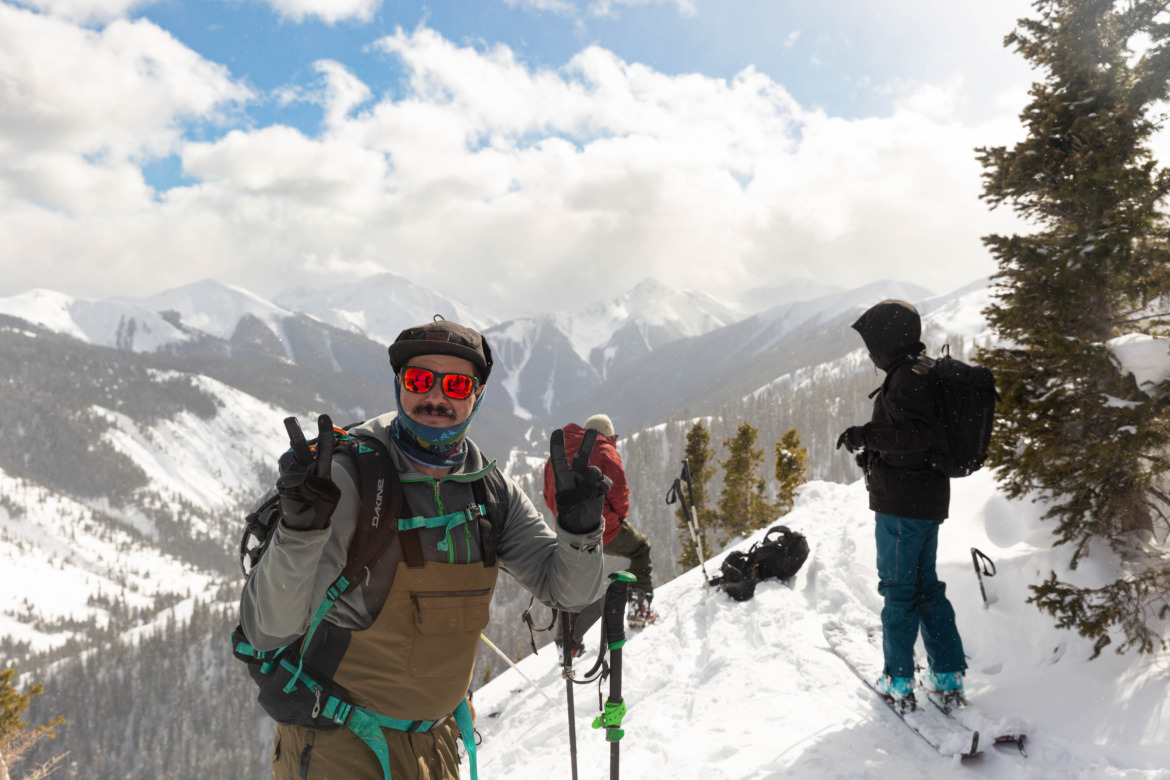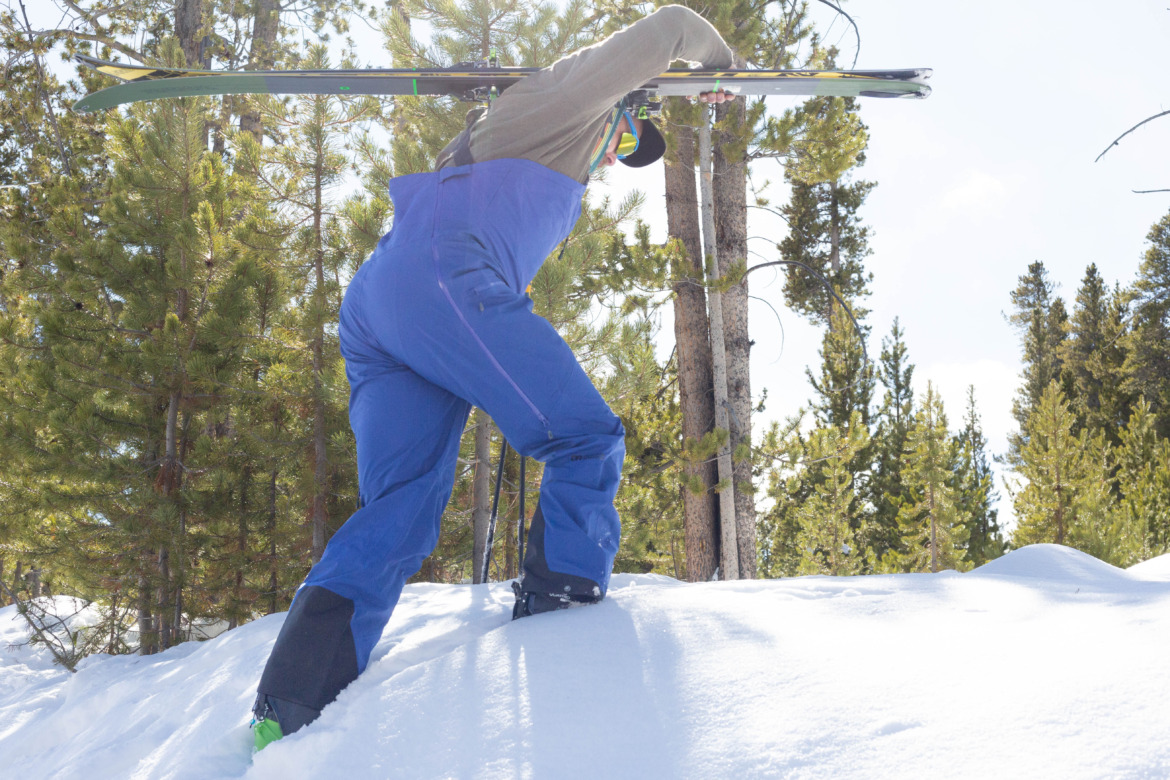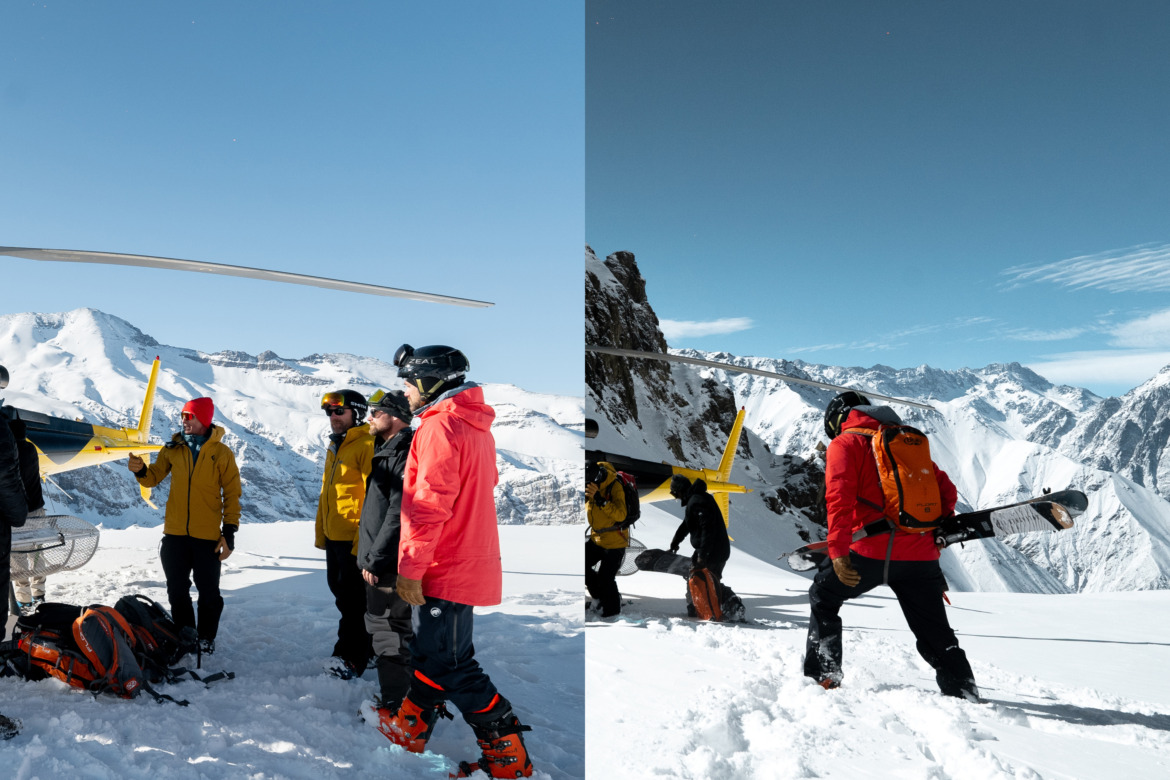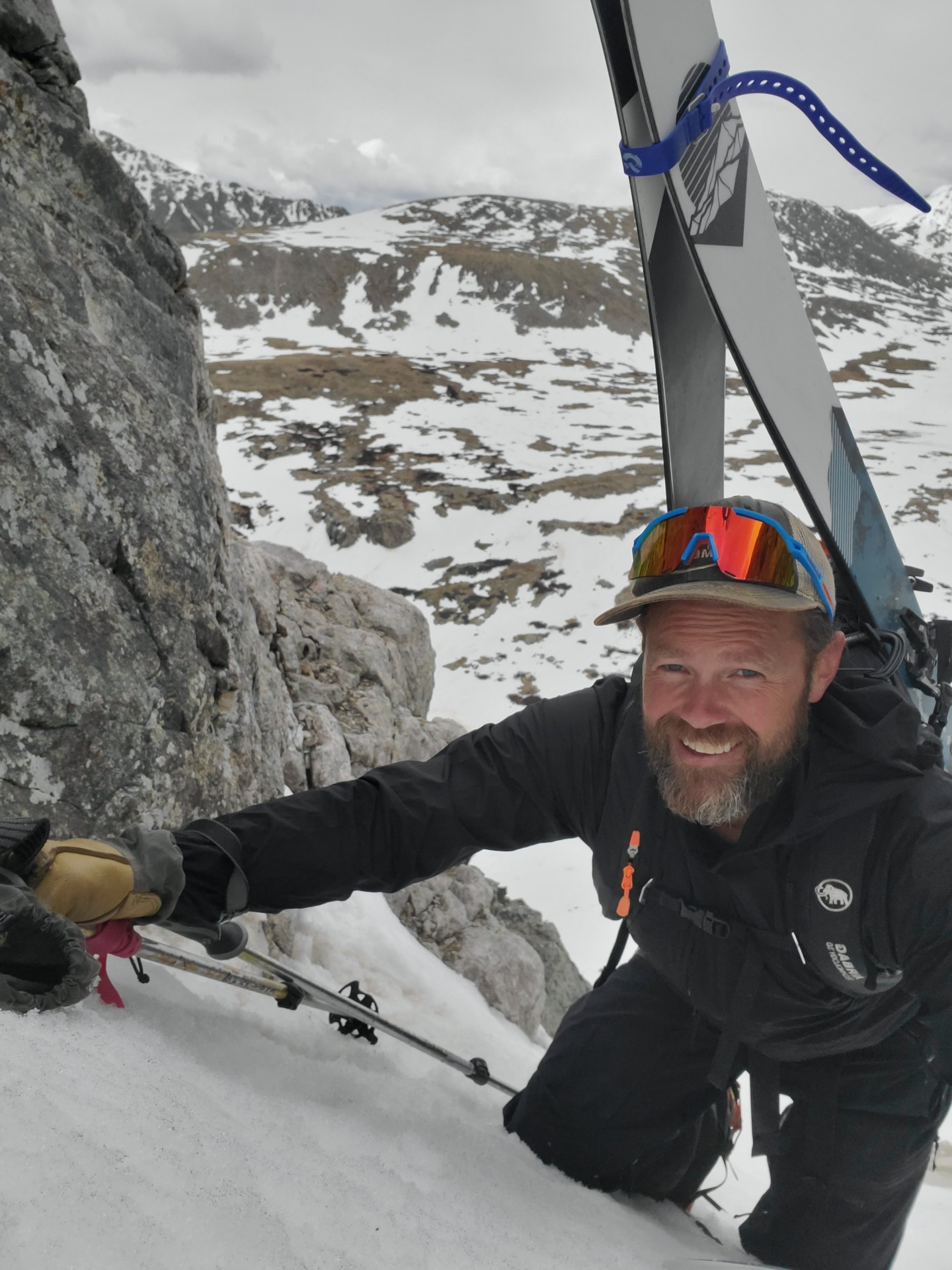If you’re not a ski bibs person, I’m not here to argue with you. I’m a bib guy. This guide is for other ski bib appreciators, but for the bib-curious, I’ll explain the pros and cons.
I primarily like backcountry ski bibs for keeping my waist uncluttered and unencumbered. With ski pants, the waistband and belt have to interface with your pack’s hip belt, your underwear, and whatever other top and bottom layers meet below your belly button. I find my shirt can’t decide whether to be in or over or just riding up and my underwear and long johns don’t fare much better. The built-in cinch mechanisms sound great but often require belt back-up which furthers the traffic jam at your waist. Oh, and don’t forget to employ your jacket’s powder skirt on deep days just to add one more at the juncture.

If you become a backcountry ski bib convert, it all seems so unnecessary. Maybe I just never learned how to wear pants.
Why Wear Bibs For Ski Touring?
Freeskier Mark Abma recently partnered with Outdoor Research on a backountry-focused ski touring bib (it sold out already) so I asked him why ski bibs and not ski pants for his kit. “{Bibs} help prevent any snow from going down your pants when you crash,” Abma said. “They also add additional warmth around your torso area. I found that if you have bib pants, a powder skirt in your jacket is no longer necessary.” More conservative tourers might not be sending and crashing as hard as Abma, but it’s nice to not worry about this issue when wearing backcountry bibs.
I also like the extra pockets and storage you get right on your chest where it’s easy to access. I find I’m often adding or subtracting upper body layers, but with bibs on, I can keep the essentials close at hand without having to transfer them as I would if I dropped a jacket layer.
No matter how paper-thin and breathable they are, however, bibs are always hotter than pants, everything else being equal. If you run cold, that can be a good thing. If you’re constantly battling overheating, bibs can exacerbate it. But with more and more ski apparel brands making bibs specifically for touring, the breathability gap between bibs and pants is shrinking slightly. Sadly, the number and variety of bibs still lag way behind pants.
I’m not sure I could’ve written this 10 years ago, but today there are dozens of touring-specific ski bibs. Some (most?) of them offer more lip service than significant material differences from resort bibs. For the most part, I haven’t mentioned those, but I do share the ski bibs I’ve tested and liked at the bottom of this article, as well as some additional options worth a sniff.
Jump ahead to our favorite backcountry bibs.
What to Look For In Ski Bibs
Fit
This may seem obvious, but it’s worth emphasizing. Backcountry ski bibs that don’t fit aren’t any good. One drawback of bibs is that the fit gets slightly more complicated to get right. The inseam/length and waist need to be right, just as with pants, but the upper body fit also has to make sense. If you have a beer gut, barrel chest, short legs, or long torso, you might have trouble finding a good pair. Women have additional complications here that I’m not qualified to guide you on.
As with any apparel, the ideal situation is to try on lots of bibs to confirm fit. With the dominance of online shopping, however, it’s not easy to find a store with dozens of bibs from different brands in your size to compare. Best you can do is narrow down on a pair or two you expect you’ll like and look for them locally or order online from stores with free and friendly returns. I try to describe fit in detail for the bibs tested below to help in this regard.
Warmth and Breathability
Most ski bibs are 3-layer shell material with Gore-Tex or some other waterproof/breathable membrane, even the ones touting their backcountry bonafides. You want a highly breathable material and the serious Gore-Tex resort jackets just don’t breathe enough for high-output touring and warmer days, no matter what they claim about the fabric tech. Air permeable membranes such as eVent perform better in this regard. Many of the bibs featured below replace the less-breathable waterproof material with other more flexible and breathable fabrics above the waist where waterproofing isn’t essential. The best options use lighter face fabrics and lots of venting to combat the inevitable steam sauna effect.
I’ll concede that there are many backcountry skiers and splitboarders that can be perfectly happy in a pair of Gore-Tex resort bibs, and if that’s you don’t let me talk you into another $500 pair of bibs that offer slight improvements to your kit. Some folks keep it casual on the uphill and don’t mind breaks to cool down. On the flip side, the skimo set isn’t really served by the backcountry bibs market (yet) and will balk at the breathability for their high-output style of skiing, except on the coldest days. The bibs on the market now mostly serve recreational tourers somewhere in the middle who are frustrated by overheating in their resort pants or bibs but aren’t ready to go full Spandex or tight softshell pants.
Waterproofing
I would argue you don’t need to obsess over waterproofing performance since the bigger danger for most touring is usually overheating and creating moisture inside the bibs than the moisture outside them. Even lower-rated waterproofing on apparel will do a good job repelling normal precip and the highest-performing membranes are just overkill for most people on most ski tours. If it’s pouring rain for hours are you actually going to stay out skinning? Will the pants/bibs be the limiting factor or your waterlogged skins? Note: I say this as someone who mostly skis at high elevations in Colorado where precipitation is less frequent, cold, and dry.
Backcountry-Specific Features
Pocket-carrying your beacon is pretty common and most ski touring bibs come with at least one pocket that’s sized and shaped to hold a beacon with some kind of tether inside. Most often, this is placed up at the chest, but I wish companies would just put a fabric loop or D-ring in every pocket so individuals can choose their own layout. Chest carry works well but on sub-zero days, I prefer to keep my phone warm close to my core, and if the beacon has to be carried there as well, it’s hard to ensure the recommended 8 inches of separation.
Vents are the other big thing I look for and, to me, the ideal is big vents on both the inside and outside of the thighs. If you’re really steaming up on a climb and need to shed heat fast, blowing open zipper vents on both sides of your legs lets any wind breeze through and pull more of that hot, moist air out. I’m of the “more is better” mindset and prefer outside vents that have double zippers running hip to knee so you can control the placement and size of the opening.
The Best Backcountry Ski Bibs to Consider

Outdoor Research Skytour AscentShell Bibs
Specs
- Weight: 768 g (774 g measured in size L)
- Waterproofing: Ascent shell 3L
- Features: Dedicated beacon pocket, gaiter pass-through for power strap
- Price: $429
Outdoor Research has been pumping out backcountry-specific bottoms for years. Their lineup has everything from Gore-Tex touring bibs like the Hemispheres II bib to beefed-up hiking pants like the light spring Cirque III pants, which have optional suspenders for a “bib light” experience. Their Skytour AscentShell Bibs hit a just-right mix of breathability and weatherproofing for season-long use both touring and on the lifts. The 10K waterproof/20K breathable AscentShell membrane is air permeable, so it lets more of the cool outside air in and hot inner air out, which can feel cool on cold resort days, but makes it a better option for touring.

They’re also softer and more flexible for a shell bib and, combined with a narrow-enough fit, are built for the constant motion of uphill skiing. The fit is roomy without being steezy and tapers to the boot so fabric doesn’t constantly rub while skinning. Front-center and right-side zips allow entry two different ways and the side zip has two zippers for adjustable venting all the way to the knee and a large side vent on the opposite leg as well. The dedicated beacon pocket is up on the chest, though I wish they also included a tether in the thigh pockets to accommodate Canadian carry. I also would really like to see inner thigh zip vents for complete blow-open when you surpass the ability of the membrane to cool you down, but overall this is a rock-solid backcountry bib for winter touring. Especially if you can find them on sale, these are the bibs I’d buy first, personally.

Helly Hansen Odin Backcountry Softshell Bibs
Specs
- Weight: 817 g measured in size L
- Waterproofing: DWR only
- Features: Dedicated beacon pocket, 4-way stretch fabric
- Price: $240
I’ve reviewed these pants in detail already after parts of multiple seasons touring in them, so check that review out for more, but I’ll summarize why I like them here. First, these are the only softshell bibs in existence that I’m aware of. The Euro brands like La Sportiva and Ortovox make plenty of softshell pants for the skimo set, but bibs must be an American thing. As contributor Bergen Tjossem argues in his Backcountry Ski Pants Guide, most backcountry skiers would benefit from switching to softshell. My guess as to why they don’t is the cultural chasm between pow-chasing recreational backcountry skiers and the skimo set in North America but that’s another story.

The softshell construction is really more of a hybrid with light shell material on the lower legs up to the knees and softshell on the backs of the legs and upper thighs. The softshell build offers a few benefits. Increased breathability is one, as your body heat and moisture don’t have to fight through a Gore-Tex-type membrane to escape. The difference isn’t overwhelming as the soft grid fleece fabric used is fairly thick and you still need to use vents to fight overheating anyway, but it’s better. Feel is probably the biggest differentiator. The four-way stretch fabric is supremely comfortable and much less stiff than shell bibs which maximizes freedom of movement on the skin up and ski down. They’re also comfortable without baselayers when spring touring which lets you stay cool without resorting to shorts. A monster difference is that you can comfortably wear them against your skin (unlike shell pants/bibs) which allows for dropping the baselayer which really lightens things up on warmer days.
The boot cuffs employ a more reinforced shell-like material which helps you keep the bibs from getting wet and an all-over DWR coating provides water-resistance for light precip. A reader commented on my longer review that his cuffs fell apart but I’m in year three using them with no more than a few boot crampon pokes in them. Overall, they’re a great option if you like high-output ascents and struggle with overheating. They’re also a touch cheaper than most of the shell bibs and Helly Hansen has them on clearance right now for $240. I’d love to see more brands follow HH’s lead and push the imaginary boundaries restricting what backcountry bibs can be.

Mammut Haldigrat Hardshell Bibs
Specs
- Weight: 496 g (603g measured in size L)
- Waterproofing: Mammut DRYTechnology Pro 3L
- Features: Dedicated beacon pocket, neoprene-lined phone pocket
- Price: $499
These are shell bibs but the 3-layer fabric is very thin and breathable with a high waterproof/breathability rating without being rigid and bulky. It’s somewhat crinkly like any shell material, but breathes well and the two-way zipper side vents help. (No inner thigh vents, sadly.) They’re also impressively lightweight and are barely noticeable hanging off your shoulders, though my pair weighed 100 grams more than their claimed product weight (likely based on a smaller size).

The Mammut Haldigrat Bibs are aimed at backcountry but worked just fine for warm South American heli skiing. Photos: Eduardo Osorio
The Mammut product page claims a freeride fit, but North Americans will find it slim. This is probably the biggest drawback for bigger folks, as the bibs are fairly snug around the waist and body and don’t have enough flexibility in the fabric to compensate if you’re squeezed into them. The good news is that the Haldigrat Bibs come in highly specific sizes based on your waist size and in regular and short lengths. I’m 6’0” 195 lbs and wear 34 waist pants, and thus went with the 34 Regular and could’ve gone to 36 regular for a roomier fit.
Like their popular touring and airbag packs, the chest beacon pocket is flagged with highlighter orange and built into the more breathable upper fabric to keep it away from competing electronic signals such as your phone. The bibs employ Mammut’s proprietary DRYTechnology Pro which has a stated 30K/30K waterproof/breathable rating and, combined with a light, flexible face fabric, reminds me a lot of Black Diamond’s Recon Stretch LT Jacket in terms of handfeel. After a few months of testing, I settled into using the Haldigrat as a hybrid bib for warm spring resort days and colder winter touring and that’s where I think it’ll fit for most people.

Backcountry Cardiac Convertible Bibs
Specs
- Weight: 809 g measured in size L
- Waterproofing: Xpore
- Features: Two dedicated beacon pocket options
- Price: $379
These house-brand bibs from online outdoor mega-retailer Backcountry.com might not have made the list if it weren’t for one key feature. Overall, they’re a bit too much like a resort bib with stiff, heavy-duty Kevlar boot cuffs and a bulkier construction than I prefer in a dedicated touring bib. But they’re essentially shell pants with a detachable bib upper that lets you change between pants and bibs if you’re not quite sure if you’re a bibs or pants person. In pants mode, the waist has Velcro cinching so you can skip a belt that competes for space with pack straps and layers around the waist.
The Cardiac bibs use a Xpore membrane and, while lighter than a resort-first Gore-Tex Pro build, they’re familiarly crinkly and not as breathable as other options here. I like the inclusion of zip vents on the inside and outside of the thigh, but each could be longer to battle overheating on the up. I could also do without the high-contrast logos on cuff and front of thigh which feel like overkill for a store brand. I like that they smartly give you beacon pockets, both on the removable upper and on the thigh, so you don’t lose the capability if you turn them into pants. I don’t like that the straps are placed far from center and tend to lay on the outside of the shoulder where they’re prone to slipping. Moving them in and/or crossing the straps in the back would alleviate this minor issue.
Gripes aside, the conversion capability isn’t a new idea in bibs, but it’s hard to find and makes the Cardiac bibs an intriguing option for folks that want one pair of bibs to pull double-duty between resort and touring and be able to flip to pants when desired on hotter days. They’re also slightly cheaper compared to the big brands.
Other Good Ski Bibs
Trew Capow Bibs: These have been my go-to touring bibs for most days over the past four seasons. However, because my pair is ancient by apparel-world standards, it appears much has changed with the materials and design of these bibs in the intervening years. I always loved how light the fabric was, the big vents on both sides of the thighs, and the fit was just roomy enough. I’ll update with a review of that latest edition if and when I’m able to test them out. I’m also curious about their new LW Bibs which are supposedly a more minimalist take on the Capow.
Patagonia SnowDrifter Bibs: I had dismissed these as just another “backcountry” bib in name that didn’t even have a beacon pocket and could easily be no more than slightly thinner resort bibs, but I’ve had people praise them and the latest version has a beacon tether at least.
Picture Welcome 3L Bibs: These are billed as a do-everything bib from eco-friendly French apparel brand Picture. The Xpore membrane is paired with a medium-light face fabric that feels like a compromise design for folks looking for one bib for both backcountry and resort. Like most European brand bibs, the fit around the core is slim and there’s no beacon attachment point, so you’ll need to wear a harness or DIY a secure loop inside a pocket. The hook-and-loop shoulder straps are wide and awesomely secure. They’re not a perfect touring bib, but could make a good 50/50 option and hats off to Picture for taking their sustainability practices to the extreme per usual.
Black Diamond Recon Stretch Bibs: On paper, the Recon Stretch Bibs look like a valid option. I’ve worn BD’s Recon Stretch LT Jacket and it’s about as light as it gets in a 3L shell. Based on weight, I’m guessing these bibs use a thicker fabric than the LT jacket, but I’ll reserve judgment until I can get my hands on a pair.
To my fellow bib appreciators, what other touring-first bibs have you tried or at least eyeballed online? As hard as I’ve tried to find and test every backcountry bib in existence, I know there are more, so this guide will be updated as I’m able to track down new options.
Oh, and spare me the speculation – none of the companies in this guide paid to get on this list. Wildsnow may earn a small commission from link clicks. And I do mean small. The authors are not affiliated with, sponsored by, or compensated by any of these brands, though the pants are often provided free of charge for testing purposes.

Justin Park is the Editor of Wild Snow. In 2009 while living in Hawaii, he got invited on a hut trip in Colorado. He had no backcountry gear, found Wild Snow, read up on backcountry skiing and bought some frame bindings for a pair of G3 Reverends so he didn’t have to buy touring boots. He moved to Breckenridge, CO a year later and today he skis 100+ days a year, most of them backcountry.
